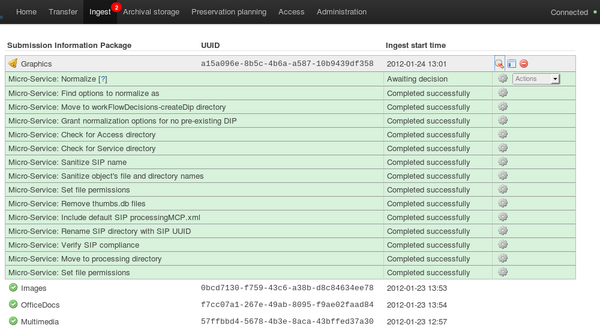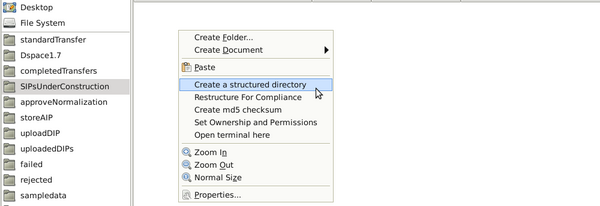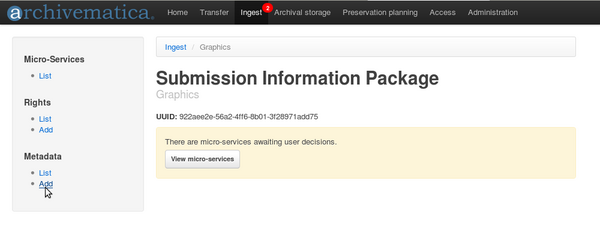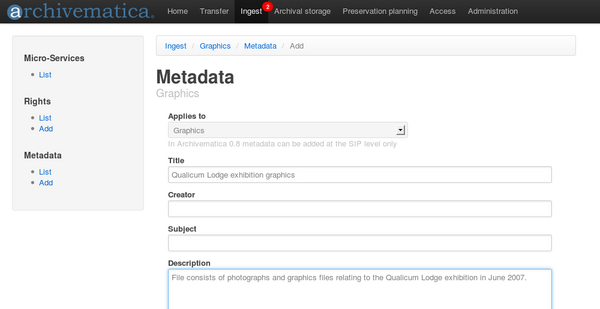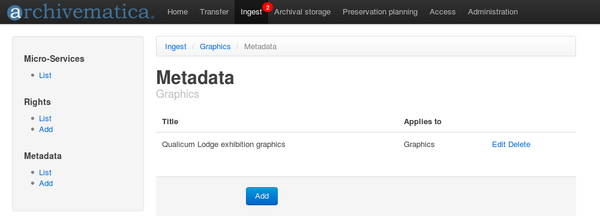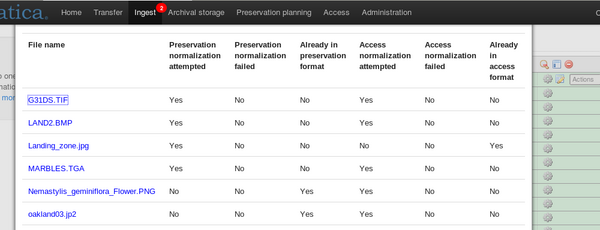Difference between revisions of "UM ingest"
m (→Normalize) |
|||
| Line 91: | Line 91: | ||
== Normalize == | == Normalize == | ||
| − | Normalizing is the process of converting ingested digital objects to preservation and/or access formats. Note that the original objects are always kept along with their normalized versions.[[Image:normalize1g.png|600px|right|thumb|'''Figure 13''' Selecting a normalization option]] | + | Normalizing is the process of converting ingested digital objects to preservation and/or access formats. Note that the original objects are always kept along with their normalized versions. For more information about preservation formats and planning, go to the Preservation Planning section of the manual. |
| + | [[Image:normalize1g.png|600px|right|thumb|'''Figure 13''' Selecting a normalization option]] | ||
#At the normalization step, the SIP will appear in the dashboard with a bell icon next to it. Select one of the normalization options from the Actions drop-down menu ('''figure 13'''): | #At the normalization step, the SIP will appear in the dashboard with a bell icon next to it. Select one of the normalization options from the Actions drop-down menu ('''figure 13'''): | ||
#*Preservation and access: creates preservation copies of the objects plus access copies which will be used to generate the DIP. | #*Preservation and access: creates preservation copies of the objects plus access copies which will be used to generate the DIP. | ||
Revision as of 19:01, 31 January 2012
Main Page > Documentation > User manual > User manual 0.8 > Ingest
General description
During ingest, digital objects are packaged into SIPs and run through several micro-services, including normalization, packaging into an AIP and generation of a DIP.
Create one or more SIP(s)
- Process one or more transfers as described in Transfer.
- While still viewing the transfer tab you should see a bell icon next to the transfer. The micro-service related to the bell is "Create SIP(s)".
- Choose one of three options for creating a SIP (or reject the transfer if desired, to stop all processing and move the transfer to the rejected folder in the file browser) (figure 1). These options are described below.
Option 1: Create single SIP and continue processing
This will create a single SIP from the transfer and move it through the initial micro-services to the normalization step.
- Once you have selected "Create single SIP and continue processing", click on the Ingest tab.
- The SIP will be running through a number of micro-services. Wait until it reaches "Normalize" and a bell icon appears (figure 2).
- To add descriptive metadata, see Add metadata, below.
- For selecting a normalization option, see Normalization, below.
Option 2: Create single SIP
This will create a single SIP from the transfer and allow the user to re-organize or delete digital objects if desired. This is useful if there has been no appraisal on the objects prior to processing in Archivematica. Note that the original order of the transfer is maintained in the transfer METS file, a copy of which is automatically added to the SIP.
- Once you have selected "Create single SIP", click on the Ingest tab.
- The SIP will appear in the dashboard with a bell icon next to it. In the file browser, open SIPsUnderConstruction using the shortcut in the left panel. Your SIP will be in this directory (figure 3).
- Open the SIP, navigate to the objects directory and delete and re-organize the objects as desired.
- Return to the dashboard. Add descriptive metadata if desired (see Add metadata, below). In the Actions drop-down menu select "SIP creation complete" (figure 4).
- Wait until the SIP reaches "Normalize" and a bell icon appears (see figure 2, above).
- If you haven't already done so, you can add descriptive metadata at this point. See Add metadata, below.
- For selecting a normalization option, see Normalization, below.
Option 3: Manual SIP creation
This option allows the user to break one transfer into more than one SIP, or to create one or more SIPs from more than one transfer. The permitted relationships between transfers and SIPs in Archivematica are completely flexible:
- One transfer --> one SIP
- One transfer --> multiple SIPs
- Multiple transfers --> one SIP
- Multiple transfers --> multiple SIPs
The user can also re-organize and delete objects within the SIP(s). Note that the original order of the transfer is maintained in the transfer METS file, a copy of which is automatically added to each SIP.
- Once you have selected "Manual SIP creation", open the file browser and navigate to SIPsUnderConstruction using the shortcut in the left panel.
- Hover your cursor over the empty right-hand panel, right-click and select "Create a structured directory" (figure 5).
- Follow the steps to create the directory and repeat the process until you have the desired number of SIPs (figure 6).
- Navigate to completedTransfers using the shortcut in the left-hand panel. Your completed transfer will be in that directory (figure 7).
- Open the transfer and cut and paste digital objects from its objects directory into the objects directories of the SIPs created in steps 1-3. Note that you must cut and paste, not copy and paste. This is to prevent you from accidentally placing the same digital object from a transfer into more than one SIP.
- Return to the dashboard and open the Ingest tab.
- Your SIPs will appear in the dashboard with bell icons next to them (figure 8).
Add descriptive metadata to the SIPs if desired (see Add metadata, below). In the Actions drop-down menu select "SIP creation complete". You can process the SIPs one at a time or at the same time if you prefer.
- Wait until the SIPs reach "Normalize" and a bell icon appears next to each SIP.
- If you haven't already done so, you can add descriptive metadata at this point. See Add metadata, below.
- For selecting a normalization option, see Normalization, below.
Add metadata
- Click anywhere on the grey background of a SIP (figure 9).
- This will take you to the SIP detail panel. On the left-hand side, under metadata click Add (figure 10).
- Add metadata as desired (figure 11) and save it by clicking the Save button at the bottom of the screen. Note that in Archivematica 0.8 you can only add metadata at the SIP level. If you would like to add metadata to a digital object, you will need to do that once the object has been uploaded to your access system.
- When you click Save, you will see the metadata entry in the list page (figure 12). To edit it further, click Edit on the right-hand side.
- Return to the ingest tab to continue processing the SIP.
Normalize
Normalizing is the process of converting ingested digital objects to preservation and/or access formats. Note that the original objects are always kept along with their normalized versions. For more information about preservation formats and planning, go to the Preservation Planning section of the manual.
- At the normalization step, the SIP will appear in the dashboard with a bell icon next to it. Select one of the normalization options from the Actions drop-down menu (figure 13):
- Preservation and access: creates preservation copies of the objects plus access copies which will be used to generate the DIP.
- Access only: no preservation copies are created. Creates access copies which will be used to generate the DIP.
- Preservation only: creates preservation copies. No access copies are created and no DIP will be generated.
- No normalization: no preservation copies are created. No access copies are created and no DIP will be generated.
- Once normalization is completed you can review the results in the normalization report. Click on the report icon next to the Actions drop-down menu (figure 14).
- The report shows what has been normalized and what is already in an acceptable preservation and access format (figure 15). For example, the file LAND2.BMP was normalized successfully to both a preservation and an access format; the file oakland03.jp2 was found to be in an acceptable preservation format already but it was necessary to generate an access copy for it.
- Approve normalization in the Actions drop-down menu to continue processing the SIP.
Store AIP
- After normalization is approved, the SIP is run through a number of micro-services, including processing of the submission documentation, generation of the METS file, generation of the DIP and packaging of the AIP.
- When these micro-services are complete, the user has two approval steps remaining in the dashboard: upload DIP and store AIP.
- If desired, open the file browser, navigate to the StoreAIP directory using the shortcuts in the left-hand panel, and review the contents of the AIP. More information on Archivematica's AIP structure and the METS/PREMIS file is available on the Archivematica wiki: see AIP structure and METS.
- Select "Store AIP" to move the AIP into archival storage (figure 16).
- For information on viewing and managing stored AIPs go to Archival storage
Upload DIP
For information on uploading the DIP, go to Access.

